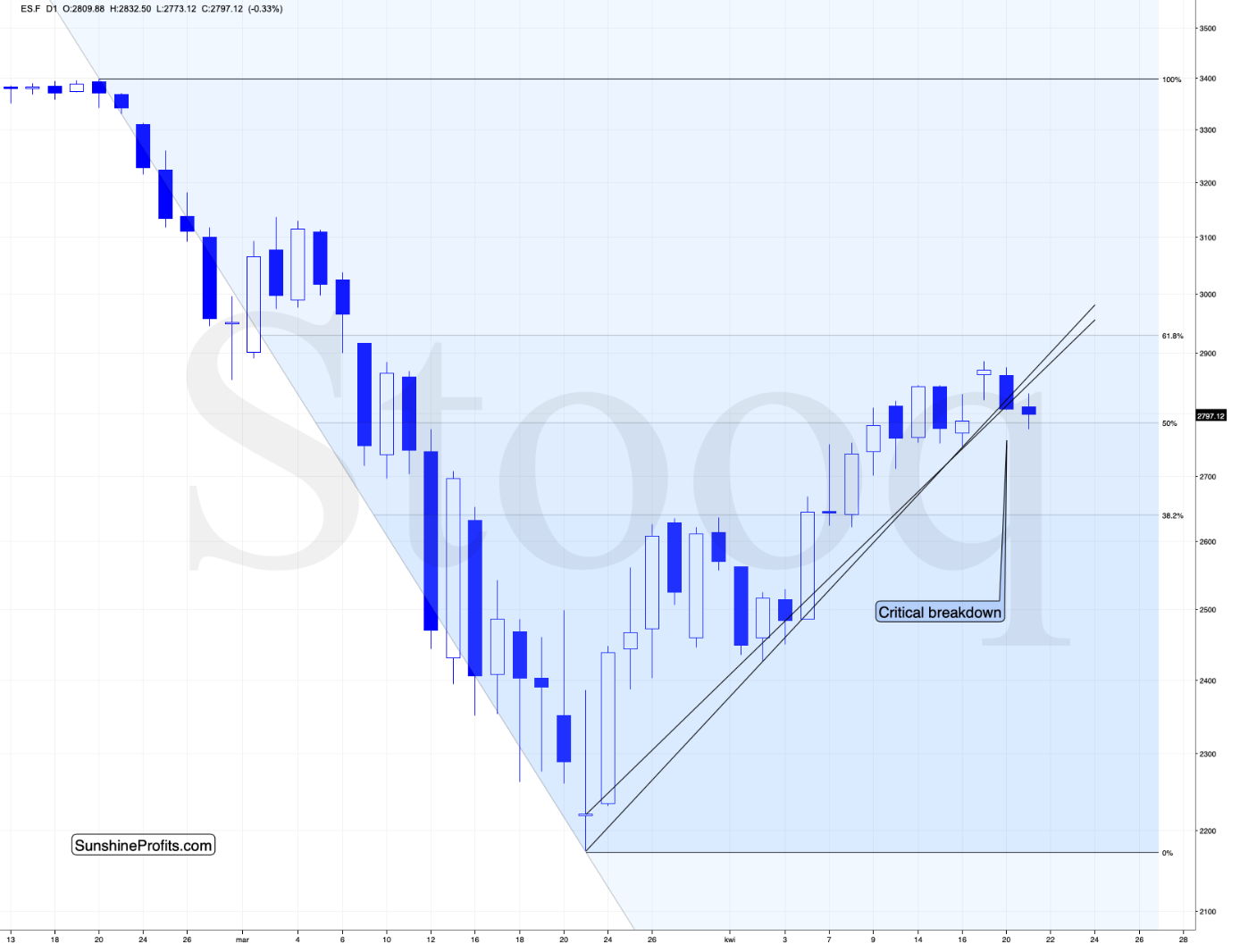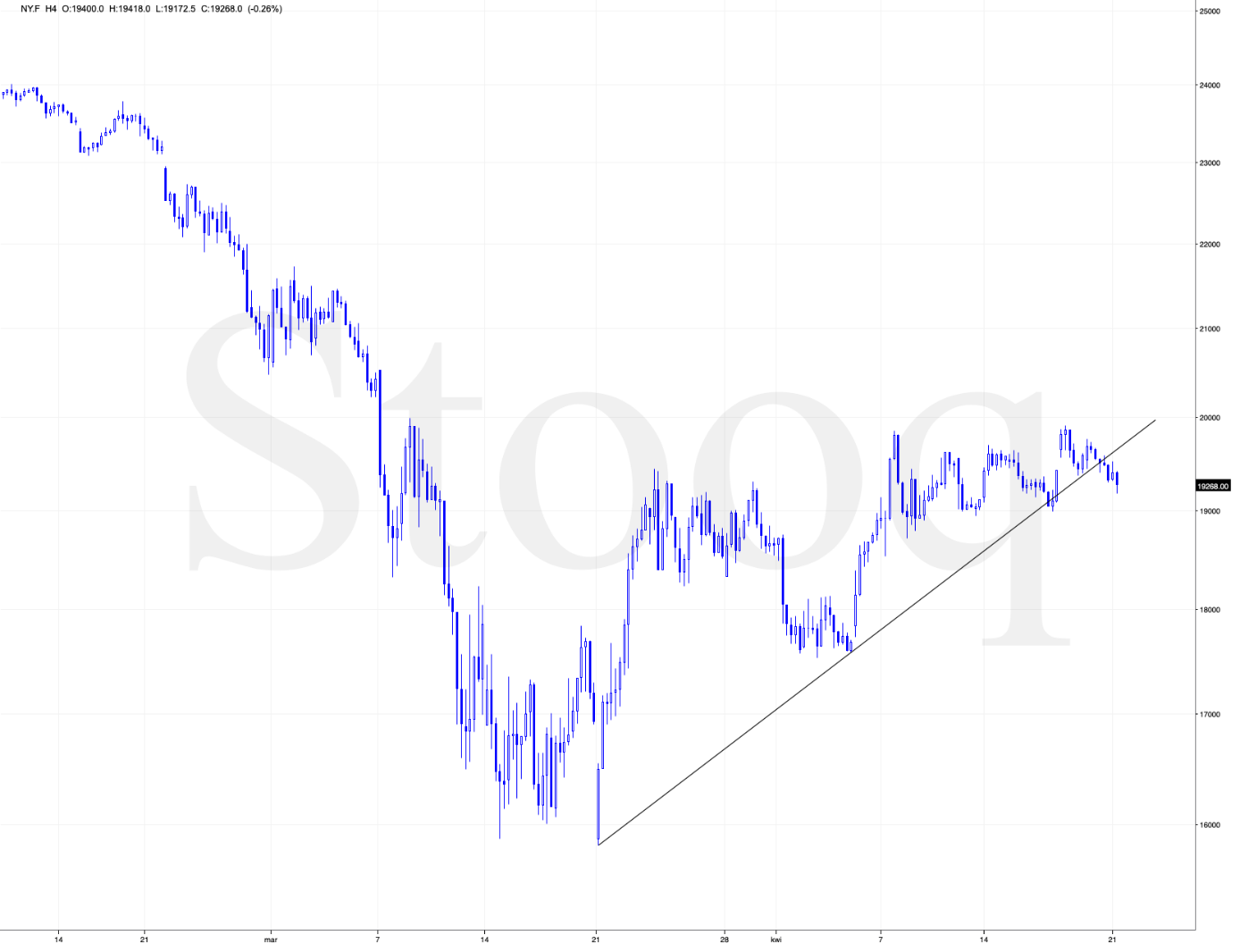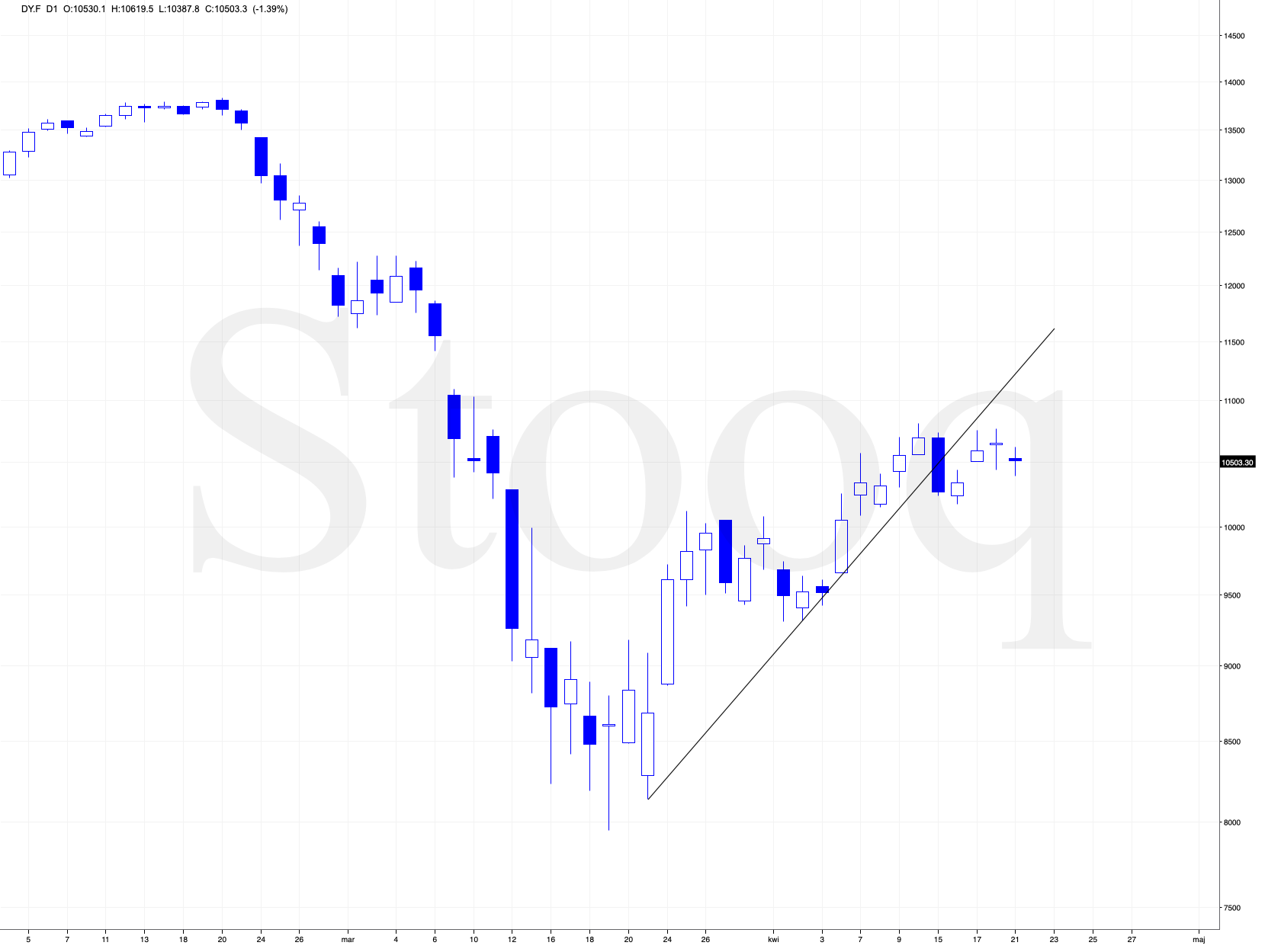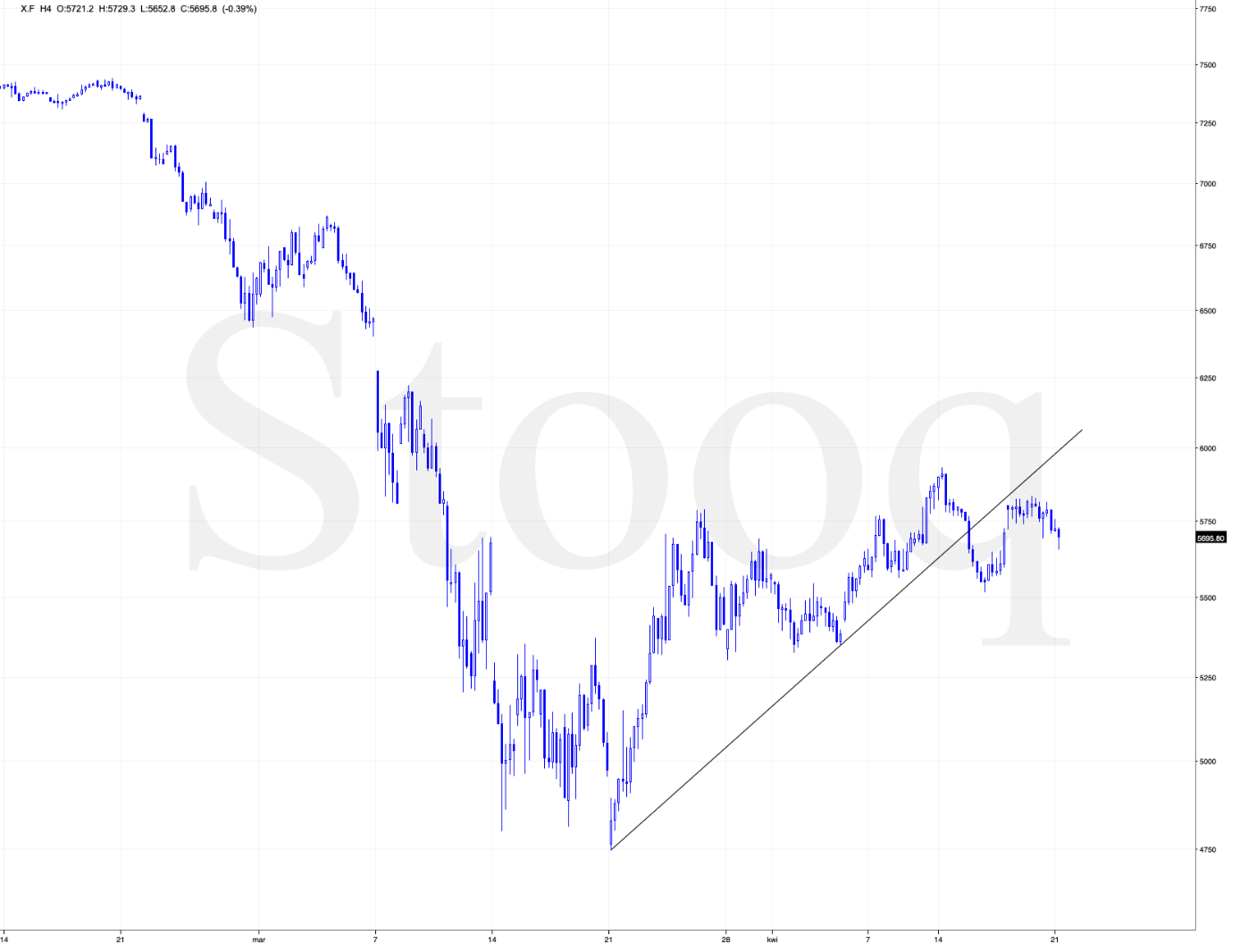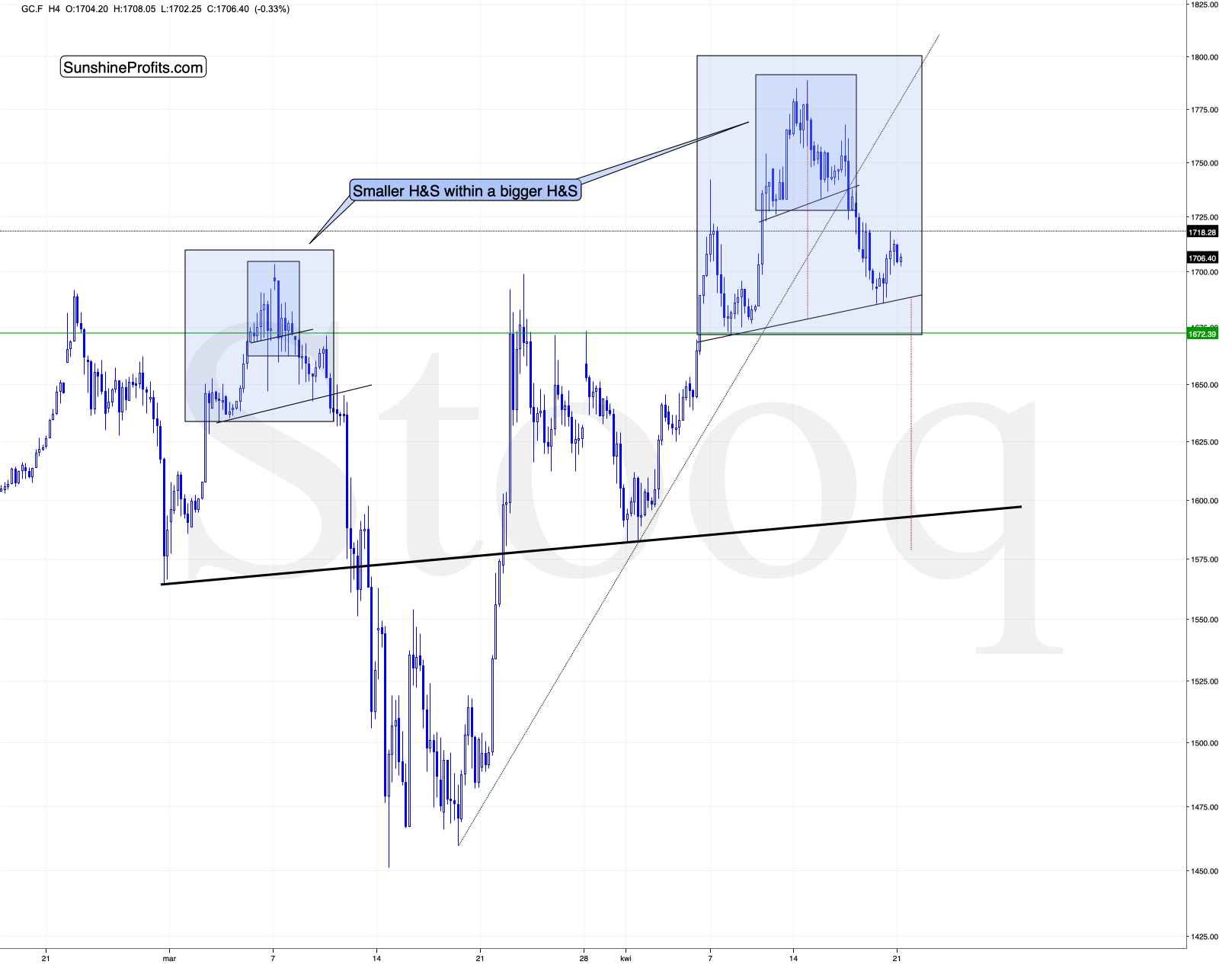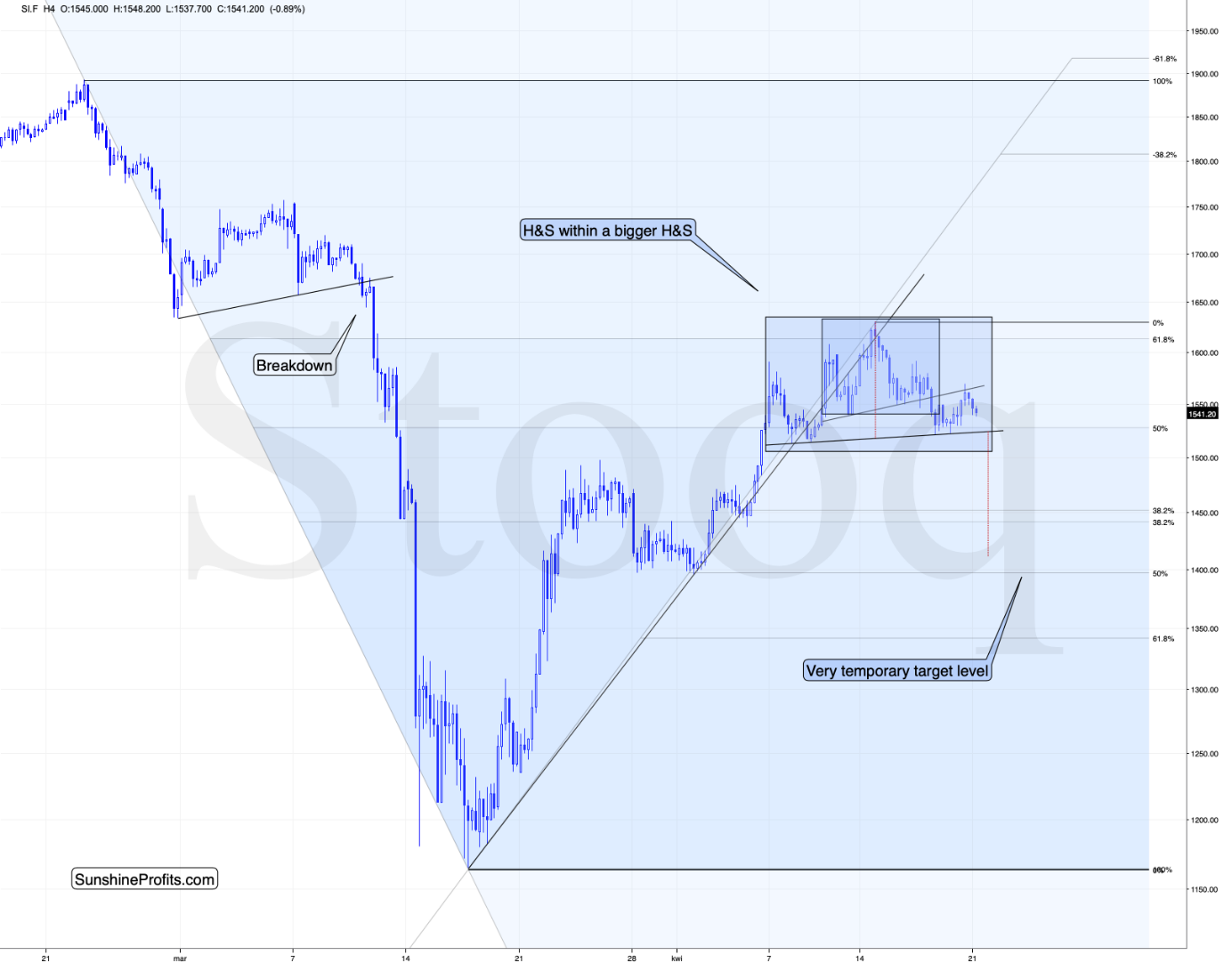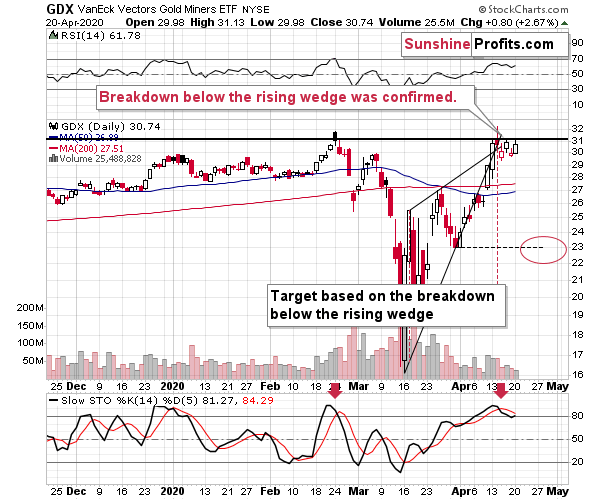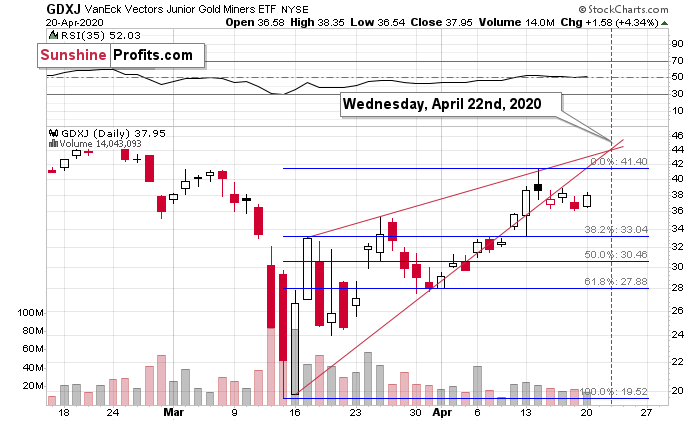Briefly: in our opinion, full (250% of the regular position size) speculative short positions in mining stocks are justified from the risk/reward point of view at the moment of publishing this Alert.
Crude oil was just trading below 0. Well, not completely, but the nearest futures contract was trading below 0 for the first time ever. Ridiculous, right? Well, yes, and no. It's not that ridiculous if you take into account bigger supply due to earlier OPEC+ disagreement and lower demand due to Covid-19. Producers have to produce crude oil on a daily basis, because shutting down production is costly. One cannot store oil just anywhere and the facilities designed for it were already getting full. This means that people were unwilling to buy it, because it was not really possible to store it. To encourage people to buy it (and take delivery) anyway, producers paid extra instead of charging per barrel - more than $30 per barrel.
Sure, it was just the May contract, which expires today and the delivery is next month. The following futures contracts (the ones that expire in the following months) are priced at about $20 or higher. But will they be able to remain as high? The market thinks that the situation will somehow be resolved within a month. But will this really be the case? If not, we could see something similar once again.
Crazy times, and economic history in the making.
Why are we starting today's Gold & Silver Trading Alert with remarks about crude oil? For two reasons. First, the above is the news that gained the spotlight yesterday, so you might have wanted to read a quick explanation. Second, this is a clear message to all investors and traders worldwide:
The unthinkable in the markets can happen, and it can happen overnight.
If anyone still thought that silver below $10 (or $9) is impossible, they probably no longer think so to. And this means that support at these levels will be much weaker, and the odds that these levels will be breached, just increased.
Actually, silver is also primarily produced as a by-product (in copper mines). As copper is produced, they also have to extract silver. This is an oversimplification, but it will be sufficient for this discussion. The point is that since the new silver supply will keep on coming anyway, the price might decline substantially if the demand doesn't match it.
Of course, there will be huge demand for silver bullion as the price moves lower... But, if the mints can't produce enough to satisfy the demand, we could see relatively high silver bullion prices while at the same time seeing a big decline in silver futures. Well, we already see this today, but based on what we saw in crude oil, it's obvious that the premium for silver could increase substantially.
The actionable part of the above is two-fold:
- If one has silver stored as insurance, we don't suggest selling it based on the likelihood of the upcoming decline, as the premium on these silver coins or bars could increase, making up for some of the decline. At the same time, it might be particularly difficult to get back in the physical market at the bottom (as described by the futures market).
- The decline in the futures market and other proxies for the precious metals market other than the physical, tangible ownership could be severe (which is in tune with what we've been expecting to see anyway).
Having said that, let's turn to charts, starting with the USD Index.
In short, the self-similarity to the early-March continues, which means that our previous comments on the above chart remain up-to-date:
The USD index soared after forming an intraday reversal. It then declined, rallied back up, and declined quickly once again - all just as it did in early March.
The final 4-hour decline was sharp and it took place as the USDX broke below the rising support line that was based on the early intraday lows. We saw the analogous decline on Friday, and the USD Index has been moving slowly up since that time. Both situations are very similar from the pattern point of view.
Back then, the analogous price action triggered further upswings, which translated into lower prices of the precious metals. The bearish implications remains in place at this time as well.
Please note that the recent price action also almost created an inverse head and shoulders pattern (we'll have H&S patterns in other markets as well). Once the USD Index breaks above the mid-April highs, the pattern will be complete, and it would like result in a rally to about 102 level.
How could the above translate into a gold price prediction?
It would simply be likely to make gold slide. Quite likely in tune with its 2008 decline.
The 2008 USD - Precious Metals Lesson
Please note what triggered the final decline in gold, silver, and mining stocks. It was the continuation of the rally in the USD Index. The first part of the decline in gold took place when the USD Index was rallying, and it soared back up when the USDX corrected.
Interestingly, the yellow metal ignored the first (late-September) rally in the USD Index and gold topped once the USD Index paused, likely based on the assumption that the USDX uptrend was already over at that time.
We saw something similar right now. Gold generally ignored USD's early-April upswing. When the USD Index corrected, gold soared, likely based on the assumption that the USDX uptrend was already over.
Right now, the USD Index seems to have started to take off once again. And this time, gold is really reacting to it - just like it did in early October 2008.
The USD Index was up by just 0.33% last week. During the same time, gold reversed and declined by 3.08% ($54). Silver was down by 4.72% ($0.76).
As the USD Index rally unfolds, the precious metals market is likely to slide, just like it did in 2008.
Please note that the shape of the most recent price moves became increasingly different from the shapes of 2008 price moves, due to various news that hit the market, for example the enormous stimulus programs.
The 1:1 link between 2008 and 2020 in terms of the price shape has definitely changed. However, this doesn't mean that the entire analogy is useless.
The way gold stopped reacting to USD's bullish signals and magnified USD's bearish signals last week tells us that gold is likely to slide shortly, just like it did in 2008. Miners moved much higher than they did during the analogous time in 2008, but they did so along with a much bigger and longer rally in the general stock market. A rally that is almost certainly unsustainable and about to turn into a huge decline. Given this link, miners are likely to slide once again, quite likely similarly profoundly to how they decline in March.
2008 - 2020 Time Analogy
Based on the most recent price moves and the big chance that we already saw the final top for this rally, we can update the analogy in terms of time.
Back in 2008, it took gold 21 trading days to rally from the September bottom to the October high.
This year, it took gold 20 trading days to rally from the March low to the April high. Almost exactly as long as in 2008.
Back in 2008 gold then declined for the next 10 trading days. It initially declined a bit over 11% and in total, it declined about 27%.
Gold has been declining for 5 trading days so far and it declined by only about 5%. If the initial decline ends at about $1,600, however, it would mean that the initial slide was about 11% - just like in 2008. The decline of 27% from the recent top would imply gold's bottom below $1,400.
If gold is to keep this analogy in terms of time or invalidate it by just a little, it would have to slide very fast this week. Yes, that's still possible.
Just like in 2008, the fundamental situation for the precious metals market just improved dramatically, but just like then, the markets are first likely to panic and push the USD higher, which would very likely translate into lower PMs and mining stock prices, especially since the general stock market is likely to slide anyway.
Speaking of the general stock market, the S&P 500 just broke below the rising support lines based on the March and early April lows. One line is based on the intraday lows, and the other on the daily closes.
Stock Market Lessons for Gold
The breakdown below these lines is a major bearish sign and something that is likely to lead to further deterioration on the stock market. As the protests against the lockdown keep popping up, the odds for the end of the lockdown actually decreased, as people participating in the protests usually don't wear masks and don't adhere to the social distancing rules. The same with Florida beaches. And there are countries when things are even worse with regard to social distancing violations.
All this increases the news-based odds for a decline in the stock market and a rally in the USD Index. However, the above chart - and the breakdown - provide the technical evidence that the next decline is quite likely already underway.
Isn't this just the thing with the US stock market? Aren't other stock indices around the world in a much better situation?
Absolutely not. Conversely, the S&P 500 was actually one of the last key stock indices that broke below its rising support line based on the March and early April lows.
We saw a breakdown in Japan's Nikkei 225, for example.
And in the German DAX.
And in the UK's FTSE.
If all or most of the major stock markets are about to fall, where will people turn to for safety? To the world's reserve currency: the US dollar. To gold as well, but not necessarily right away.
Why? Because it seems likely that gold is getting ready for a slide below $1,600.
Gold just invalidated the breakout above the $1,700 level and the breakout above the inverse head-and-shoulders formation in intraday terms. This is a major sell confirmation.
Shortly thereafter, gold moved above $1,700 once again, but this time, the rally was nothing to call home about. Gold just moved to about $1,720 before starting to decline once again.
Moreover, on a short-term note, we see that the USD Index wasn't the only market that's been repeating its early March performance. Gold has been trading in a very similar way as well. We marked the similar patterns with blue rectangles.
Back in March, gold topped in a head-and-shoulders formation, and we saw the same pattern also recently. In March, gold plunged as it got a strong boost from the rising USD Index.
Right now, gold didn't get the USDX boost, and... It's been declining decisively nonetheless. This is a very bearish combination, because it shows that gold just can't wait to slide lower.
The next support is theoretically at the early April lows, but given gold's weakness relative to the USDX and the fact that the latter is likely to soar shortly, it seems rather unlikely that gold will decline by just $25 or so. A move several times larger seems more likely. The nearest strong support level that fills this requirement is the early April low - a bit below $1,600.
That's our next interim target that could generate a (dead cat) bounce before the decline continues.
Interestingly, gold didn't just create one head and shoulders formation. The smaller head-and-shoulders formation (the one that formed between April 12th and April 16th) seems to be the head of a bigger H&S pattern. The left shoulder is the April 6th - April 7th top, and the right shoulder is what we saw form yesterday and today.
What is even more interesting, we could also see such a double-H&S pattern in early March. Completion of the bigger H&S pattern was what started the biggest decline of this year (so far). The implications here are very bearish, even though forming the right shoulder might not appear favorable (after all, gold had to move somewhat higher for the right shoulder to form).
And do you know where's the target for the bigger H&S pattern? A bit below $1,600 - that's in perfect tune with what we wrote previously based on other factors. Consequently, an interim bottom in this area is even more likely.
What about silver?
In short, the major 2008 - 2020 analogy in terms of price moves remains intact.
As far as silver's short-term picture is concerned... We not only see a relatively similar consolidation to what happened in early March. We also see a double-H&S pattern, just like the one in gold, and we see that silver has been consolidating for several days after already breaking below its rising support line.
This is a powerful combination of bearish factors for the short term.
And what about the miners?
Miners moved higher, just as gold did (within the same trading hours). The move took place on very low volume, and it failed to take miners above their previous highs, or the lower border of the rising wedge pattern.
Moreover, the sell signal from the Stochastic indicator remains in place.
In other words, yesterday's upswing didn't change anything.
The same with the GDXJ ETF. In case of the junior miners, the upswing was smaller. We previously indicated that the junior miners are likely to be weaker than seniors during this downswing, and this remains to be the case.
So, why are the miners still relatively high, while gold moved visibly below their previous highs? There are three possible explanations, and it seems likely that they all play an important part:
- Gold futures rallied profoundly recently, but other proxies for gold, for instance the GLD ETF didn't move as high. And then, they didn't decline as significantly as gold futures did. Consequently, gold miners' reaction might not be so muted - instead, we might be comparing it to the most volatile proxy for gold investment.
- Gold miners are not only correlated with gold, but also with the general stock market. As the general stock market didn't decline significantly so far, neither did miners.
- It is quite often the case that the weakest part of a given market acts particularly strong at the end of the rally, as the investment public enters the market and buys everything that looks cheap, regardless of the reasons that made these assets so cheap in the first place. Miners were one of the worst performing parts of the general stock market - at least during the March decline. It could be the case that miners' strong performance in the recent days is simply a consequence of a topping stock market.
All in all, the situation for the mining stocks didn't improve, even though it might appear to be the case at the first sight.
Finally, before summarizing, we would like to reply to questions that we received recently.
From the Readers' Mailbag
Q: The situation seems very bad as:
- the USD is up and done every day but not on a strong upside,
- gold is up gain near 1'700,
- the momentum on GDX is so strong and going back today nearly 31 (+ 3 %)
Is it possible that gold and GDX are going on the upside and not on the down side?
A: Of course, it is possible that gold and GDX are going to rally instead of declining. However, it doesn't seem likely.
The first point is a fact, but it doesn't have any bearish implications. Yes, USDX is consolidating, a bit longer than it did in early March, but the shape of the movement is very similar. In fact, the recent back and forth movement in the USDX created the right shoulder of the inverse head and shoulders formation. Once completed, this formation is likely to catapult the greenback to higher levels.
The second point is a fact as well, but - again - this doesn't imply anything. Just because a given move takes a bit longer, doesn't mean it's not taking place. In this case, the delay is likely to result in a bearish H&S formation and a slide below $1,600 in the following days.
The third point is not a fact. The momentum in GDX is not strong - the mining stocks have failed to move back above their previous 2020 high and the resistance level in the form of the rising support line. They also moved higher on very weak volume, which is not a sign of strength.
The markets are not invalidating their previous outlooks - they are pausing, consolidating, and... preparing.
Summary
Summing up, the outlook for the precious metals market remains bearish for the next few weeks, despite the upswing that we saw recently. In fact, based on the way the USD Index moved last week, it seems that the top in the PMs and miners is already in and the final part of the decline has already started.
Gold showed exceptional weakness by invalidating the inverse head-and-shoulders pattern and closing the previous week below $1,700 despite almost no help from the USD Index, which is a screaming sell indication.
Even though mining stocks moved higher yesterday, their technical picture remains bearish.
If you've been staying on the sidelines, or have been waiting for a good moment to add to the short positions (or open them at all), in our opinion, this is a good moment to do so. The risk to reward ratio appears particularly favorable right now.
After the sell-off, we expect the precious metals to rally significantly. The decline might take as little as 1-3 weeks, so it's important to stay alert to any changes.
We are adjusting the profit-take levels for the leveraged ETNs (DUST and JDST) and we are providing additional post-reverse-split price targets for them as well. To make sure you're positions are not realized immediately after the reverse split, we suggest cancelling the exit orders before Wednesday's close, and re-entering them once the trading starts on Thursday.
Most importantly - stay healthy and safe. We're making a lot of money on these price moves (and we'll likely make much more in the following weeks and months), but you have to be healthy to really enjoy the results.
By the way, we recently opened a possibility to extend one's subscription for a year with a 10% discount in the yearly subscription fee (the profits that you took have probably covered decades of subscription fees...). It also applies to our All-Inclusive Package (if you didn't know - we just made huge gains shorting crude oil and are also making money on both the decline and temporary rebound in stocks). The boring time in the PMs is over and the time to pay close attention to the market is here - it might be a good idea to secure more access while saving 10% at the same time.
Important: If your subscription got renewed recently, but you'd like to secure more access at a discount - please let us know, we'll make sure that the discount applies right away, while it's still active. Moreover, please note that you can secure more access than a year - if you secured a yearly access, and add more years to your subscription, each following year will be rewarded with an additional 10% discount (20% discount total). We would apply this discount manually - please contact us for details.
Secure more access at a discount.
As always, we'll keep you - our subscribers - informed.
To summarize:
Trading capital (supplementary part of the portfolio; our opinion): Full speculative short positions (250% of the full position) in mining stocks is justified from the risk to reward point of view with the following binding exit profit-take price levels:
Senior mining stocks (price levels for the GDX ETF): binding profit-take exit price: $10.32; stop-loss: none (the volatility is too big to justify a SL order in case of this particular trade); binding profit-take level for the DUST ETF: $9.27 (after the 1 for 25 reverse-split that's scheduled after the Apr 22 close: $231.75); stop-loss for the DUST ETF: none (the volatility is too big to justify a SL order in case of this particular trade)
Junior mining stocks (price levels for the GDXJ ETF): binding profit-take exit price: $9.57; stop-loss: none (the volatility is too big to justify a SL order in case of this particular trade); binding profit-take level for the JDST ETF: $11.37 (after the 1 for 25 reverse-split that's scheduled after the Apr 22 close: $284.25); stop-loss for the JDST ETF: none (the volatility is too big to justify a SL order in case of this particular trade)
For-your-information targets (our opinion; we continue to think that mining stocks are the preferred way of taking advantage of the upcoming price move, but if for whatever reason one wants / has to use silver or gold for this trade, we are providing the details anyway. In our view, silver has greater potential than gold does):
Silver futures downside profit-take exit price: $8.58
Gold futures downside profit-take exit price: $1,312 (the target for gold is least clear; it might drop to even $1,170 or so)
Long-term capital (core part of the portfolio; our opinion): No positions (in other words: cash)
Insurance capital (core part of the portfolio; our opinion): Full position
Whether you already subscribed or not, we encourage you to find out how to make the most of our alerts and read our replies to the most common alert-and-gold-trading-related-questions.
Please note that the in the trading section we describe the situation for the day that the alert is posted. In other words, it we are writing about a speculative position, it means that it is up-to-date on the day it was posted. We are also featuring the initial target prices, so that you can decide whether keeping a position on a given day is something that is in tune with your approach (some moves are too small for medium-term traders and some might appear too big for day-traders).
Plus, you might want to read why our stop-loss orders are usually relatively far from the current price.
Please note that a full position doesn't mean using all of the capital for a given trade. You will find details on our thoughts on gold portfolio structuring in the Key Insights section on our website.
As a reminder - "initial target price" means exactly that - an "initial" one, it's not a price level at which we suggest closing positions. If this becomes the case (like it did in the previous trade) we will refer to these levels as levels of exit orders (exactly as we've done previously). Stop-loss levels, however, are naturally not "initial", but something that, in our opinion, might be entered as an order.
Since it is impossible to synchronize target prices and stop-loss levels for all the ETFs and ETNs with the main markets that we provide these levels for (gold, silver and mining stocks - the GDX ETF), the stop-loss levels and target prices for other ETNs and ETF (among other: UGLD, DGLD, USLV, DSLV, NUGT, DUST, JNUG, JDST) are provided as supplementary, and not as "final". This means that if a stop-loss or a target level is reached for any of the "additional instruments" (DGLD for instance), but not for the "main instrument" (gold in this case), we will view positions in both gold and DGLD as still open and the stop-loss for DGLD would have to be moved lower. On the other hand, if gold moves to a stop-loss level but DGLD doesn't, then we will view both positions (in gold and DGLD) as closed. In other words, since it's not possible to be 100% certain that each related instrument moves to a given level when the underlying instrument does, we can't provide levels that would be binding. The levels that we do provide are our best estimate of the levels that will correspond to the levels in the underlying assets, but it will be the underlying assets that one will need to focus on regarding the signs pointing to closing a given position or keeping it open. We might adjust the levels in the "additional instruments" without adjusting the levels in the "main instruments", which will simply mean that we have improved our estimation of these levels, not that we changed our outlook on the markets. We are already working on a tool that would update these levels on a daily basis for the most popular ETFs, ETNs and individual mining stocks.
Our preferred ways to invest in and to trade gold along with the reasoning can be found in the how to buy gold section. Additionally, our preferred ETFs and ETNs can be found in our Gold & Silver ETF Ranking.
As a reminder, Gold & Silver Trading Alerts are posted before or on each trading day (we usually post them before the opening bell, but we don't promise doing that each day). If there's anything urgent, we will send you an additional small alert before posting the main one.
Thank you.
Sincerely,
Przemyslaw Radomski, CFA
Editor-in-chief, Gold & Silver Fund Manager




